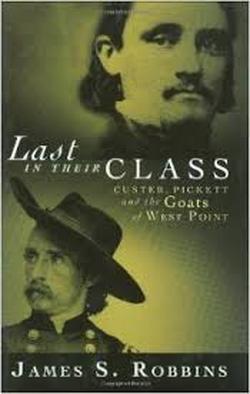
James S. Robbins
Encounter Books, 2006, 503 pp. + 13 pp. introduction, $26.95
ISBN: 9781594031410
Image Courtesy of amazon.com
There have been many books about the students of West Point and their accomplishments during the American Civil War but very little detail has been given to the “Goats” of the academy. For some, they wear it with a badge of honor, but for others the title is the most demeaning thing which can be bestowed upon you during your graduation. James S. Robbins presents in this book, a look at the people who graduated at the very last in their class and the effect which they procured upon conflict. Much like the work, The Class of 1846, this book chronicles the events from the time at the academy all the way to the surrender at Appomattox and for some, even farther.
James S. Robbins is a professor of international relations at the National Defense University in Washington and is a former assistant in the Office of the Secretary of Defense. There are some who might be familiar with Robbins work as he is often writing for the National Review, The Wall Street Journal and other major publications.
Upon a first look at this book, there was a bit of an assumption that it would be filled with profiles and short biographies of the goats of West Point and their accomplishments in the war. As I began to read, I began to discover that this was not the case for this book. What is placed in these pages is a narrative of the lives of the commanders during the Civil War who just happened to be placed last in their class which includes both Pickett and Custer. Robbins does not just mention the goats of West Point, but the others in the class who have long shadows these men had to stand under including Jefferson Davis, Robert E. Lee and Patrick O’Rourke. He makes the interesting point on Custer that he only graduated last in his class due to the fact that he was pushed through the academy in order to fulfill the officer roster on the cusp of the Civil War. One of the major issues which was constant throughout the text was the focus the author placed on Custer. Understandably, Custer was one of the more successful goats to come out of West Point during the war, but this book seems more of a biography on the man instead of what the book sets out to do. There was also too much background information on the history of the school instead of the people who went there. The information, however, is good information but just not a focused narrative. The look into the lives of Pickett, Heth and many others are a backseat narrative and pops more into play as a newsflash in the middle of the narrative on Custer instead of a separate narrative on themselves. The subtitle of the book does not even mention that the men he will be talking about are fighting in the Civil War. It is, however, implied in the case due to the placement of Pickett’s name in the subtitle.
This works suffers from the main flaw in the plan of the book. The title lacks everything which the book has going for it in the fact that he only goes out of his way to talk about Custer. There is nothing wrong with writing a biography of Custer, but by attempting to place others in the Civil War in this book along with Custer feels out of place and poorly edited. While the narrative suffers from the randomness of the information, people will find it very readable and the work is fairly sourced. But amongst the myriad of other Civil War West Point histories out there, this one is far from being recommended. Robbins set out with good intentions but missed his mark greatly by ignoring the very premise in which he has written his book. This is nothing more than a glorified biography on Custer with a few others implemented in the narrative.
 RSS Feed
RSS Feed
